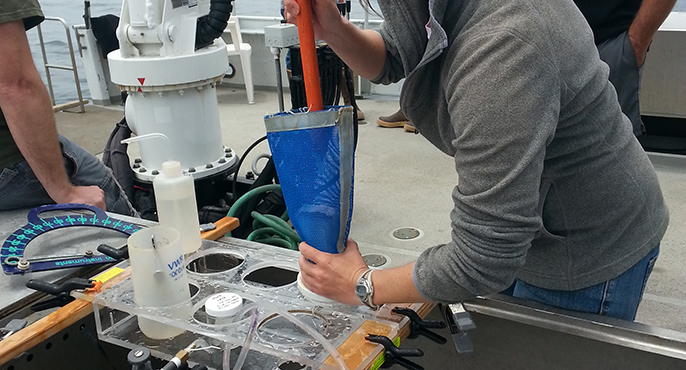DNA barcode sequencing – or DNA barcoding – is a molecular method to identify organisms using short regions, or “barcodes,” of their genomes. SCCWRP is working to develop, test and implement methods and tools that will enable DNA-based approaches to be used for routine environmental monitoring. As California’s water-quality management community increasingly relies on biology-based assessments of water body condition, DNA barcoding has the potential to become a more rapid, cost-effective, accurate way to generate the taxonomic data necessary to support routine environmental monitoring programs.
DNA barcoding methods can be used to survey a variety of organisms across a range of aquatic habitats, from algae to fish larvae to threatened and endangered species. Not only does DNA barcoding provide a minimally invasive option for monitoring aquatic species, but it also can be used to survey both intact organisms and trace DNA that organisms leave behind in their environment – known as environmental DNA, or eDNA. In particular, eDNA can provide a key line of evidence for the presence of invasive, endangered and rare species, which are difficult to assess through traditional sampling because of their motility and often disparate distribution.
Multi-pronged effort to improve DNA barcoding
SCCWRP’s approach to developing DNA-based approaches for bioassessment and biomonitoring applications is broken down into six main stages:

- Field sampling: SCCWRP is working with academic and agency partners to develop a suite of standardized field methods for collecting environmental samples for DNA applications. In the absence of standardization, researchers have developed a range of collection methods for obtaining DNA samples from a range of sources, from benthic organisms to surface sediments to water filtrate; each sampling protocol can introduce unknown biases that affect results. SCCWRP also is working to better understand the propagation and degradation of eDNA in the natural environment, with a goal to better understand the extent of eDNA transit to predict species distributions.
- Sample processing: SCCWRP is working to develop a suite of best practices and recommended protocols for each stage of DNA sample processing, from DNA extraction to amplification to sequencing. While DNA processing methods are fairly routine and can be achieved using numerous commercially available kits and technologies, water-quality managers need assurances that comparable DNA-based data are being generated regardless of sample processing techniques. Traditionally, quality-control measures (e.g., negative and positive controls, microbial DNA standards) have not been consistently implemented. Likewise, researchers have not yet reached consensus on optimal sample processing protocols for various specific habitats and target species. For example, algal biofilms and water filtrate may require different approaches for extracting, cleaning and amplifying DNA. Similarly, SCCWRP and its partners are still working to reach consensus on the most effective DNA barcode regions to target in the genomes of priority taxa such as algae and invertebrates (which are used in bioassessment-based environmental monitoring).
- Bioinformatics: SCCWRP is working to develop best-practices recommendations for analyzing raw DNA sequences and generating usable, quality-screened, polished DNA sequence data – a series of analysis and quality-control steps known as a bioinformatics pipeline. Multiple published and home-grown bioinformatic computational pipelines already are available to researchers, with new methods published almost daily. However, the field of bioinformatics is evolving so rapidly that it’s become difficult to ensure that these bioinformatics pipelines all yield comparable, high-quality, consistent results. In addition to determining confidence levels associated with existing bioinformatics pipelines, SCCWRP is developing training programs to help transition these methods to end-user communities.
- DNA library: SCCWRP and its partners are building expanded libraries of DNA reference sequencing data for key taxa to improve researchers’ capacity to identify organisms via DNA barcoding. Although researchers rely on reference libraries to match their data to a target species, the reference libraries for priority organisms – including marine invertebrates, benthic meiofauna and freshwater algae – have not yet been adequately built out. SCCWRP has partnered with a number of sampling teams across a range of freshwater and marine environments to accelerate expansion of these reference libraries.
- Biological indices: SCCWRP is working to incorporate DNA-based taxonomic identification methods into routine monitoring programs that use biological indices to assess water body condition. Biological indices, or indices of biotic integrity, are quantitative scoring tools for evaluating the condition of a water body by assessing the composition of its biological communities. Because traditional morphology-based identification of these organisms under a microscope is prone to delays and high costs, SCCWRP is working to show how DNA barcoding potentially could be used in parallel with and/or in place of traditional morphological identification for key algae and invertebrate species; in some cases, DNA barcoding has the potential to improve taxonomic resolution. SCCWRP also is exploring development of novel types of biological indices, including “taxonomy-free” indices that rely solely on DNA data.
- Implementation: To ensure DNA barcoding methods are transitioned successfully to end users, SCCWRP is chairing a California Water Quality Monitoring Council workgroup that is developing a suite of recommended protocols and best practices for collecting and analyzing DNA-based data. This Molecular Methods Workgroup, comprised of federal, state and tribal agencies as well as academia, will focus on creating reference materials to help train the broader user community, and accelerating the integration of these methods into routine management and regulatory programs.

